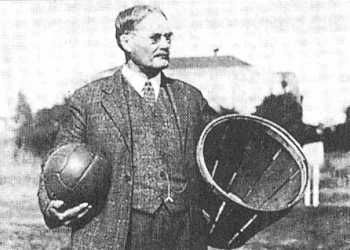Basketball History: Origin of the Sport
Basketball, James Naismith original idea.
In contrast to other sports, basketball has a clear origin. It is not the evolution from an ancient game or another sport and the inventor is well known: Dr. James Naismith.
Naismith was born in 1861 in Ramsay township, Ontario, Canada. He graduated as a physician at McGill University in Montreal and was primarily interested in sports physiology.
In 1891, while working as a physical education teacher at the YMCA International Training School (today, Springfield College) in the United States, Naismith was faced with the problem of finding in 14 days an indoor game to provide "athletic distraction" for the students at the School for Christian Workers (Naismith was also a Presbyterian minister).
 After discarding the idea of adapting outdoor games like soccer and lacrosse, Naismith recalled the concept of a game of his school days known as duck-on-a-rock that involved accuracy attempting to knock a "duck" off the top of a large rock by tossing another rock at it.
After discarding the idea of adapting outdoor games like soccer and lacrosse, Naismith recalled the concept of a game of his school days known as duck-on-a-rock that involved accuracy attempting to knock a "duck" off the top of a large rock by tossing another rock at it.
Starting from there, Naismith developed a set of 13 rules that gave origin to the game of basketball.
Of course it was not exactly as we know it today. The first game was played with a soccer ball and two peach baskets nailed 10-feet high used as goals, on a court just half the size of a present-day court. The baskets retained their bottoms so balls scored into the basket had to be poked out with a long dowel each time and dribbling (bouncing of the ball up and down while moving) was not part of the original game.
The sport was an instant success and thanks to the initial impulse received by the YMCA movement, basketball's popularity quickly grew nationwide and was introduced in many nations. Although Naismith never saw the game develop into the spectacular game we know these days, he had the honor to witness basketball become an Olympic sport at the 1936 Games held in Berlin.
These are James Naismith original thirteen rules of basketball:
- The ball may be thrown in any direction with one or both hands.
- The ball may be batted in any direction with one or both hands, but never with the fist.
- A player cannot run with the ball. The player must throw it from the spot on which he catches it, allowance to be made for a man running at good speed.
- The ball must be held in or between the hands. The arms or body must not be used for holding it.
- No shouldering, holding, pushing, striking or tripping in any way of an opponent. The first infringement of this rule by any person shall count as a foul; the second shall disqualify him until the next goal is made or, if there was evident intent to injure the person, for the whole of the game. No substitution shall be allowed.
- A foul is striking at the ball with the fist, violations of Rules 3 and 4 and such as described in Rule 5.
- If either side make three consecutive fouls it shall count as a goal for the opponents (consecutive means without the opponents in the meantime making a foul).
- Goal shall be made when the ball is thrown or batted from the ground into the basket and stays there, providing those defending the goal do not touch or disturb the goal. If the ball rests on the edge and the opponents move the basket, it shall count as a goal.
- When the ball goes out of bounds, it shall be thrown into the field and played by the first person touching it. In case of dispute the umpire shall throw it straight into the field. The thrower-in is allowed five seconds. If he holds it longer, it shall go to the opponent. If any side persists in delaying the game, the umpire shall call a foul on them.
- The umpire shall be judge of the men and shall note the fouls and notify the referee when three consecutive fouls have been made. He shall have the power to disqualify men according to Rule 5.
- The referee shall be the judge of the ball and decide when it is in play in bounds, to which side it belongs, and shall keep the time. He shall decide when a goal has been made and keep account of the goals with any other duties that are usually performed by a referee.
- The time shall be two 15-minute halves with five minutes' rest between.
- The side making the most goals in that time shall be declared the winners.